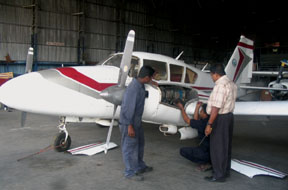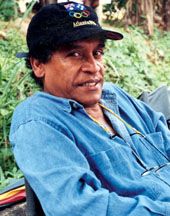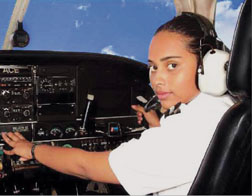|
observer |
|
|
|
|
|
OTHER LINKS |

|

|

|
|
The sky is the limit with Chandran's AAC: Asian Aviation Centre (AAC), the premier Aeronautical Engineering and Flying Academy in Sri Lanka
However, prospects for those who wish to follow, at least part of their Aeronautical Engineering Courses here is not so bleak, thanks to Asian Aviation Centre, masterminded by veteran film producer and art lover Chandran Ratnam who dreamt of conquering the aviation field. "I was the sort of guy who would go to an Airport and watch the planes taking off. I remember as a kid, I went to the Colombo port and watched the ships coming and going out. I do not know whether it was wonder, luck or freedom of movement. I do not know which one it was. Some years ago a friend of mine and I decided that we should have an airline.
In the hope of realizing his cherished dream, Ratnam explored the possibility of procuring helicopters with a like minded friend and found out that it was beyond their means. So, the idea was put on back burner for some time. However, Ratnam did not completely give up the idea. With a tip off on those two Russian built helicopters in Maldives, enthusiastic Ratnam moved into action and bought the two helicopters with the intention of starting a scheduled helicopter service. As Chandran Ratnam realized that it was not commercially viable to start a helicopter service with two helicopters, he shelved off the idea but decided to go for fixed wing aircrafts, thus laying the foundation for the domestic airline Lion Air. With aircrafts bought from Kazakastan, Lion Air commenced its operation in 1994. However, in 1998, flying was banned following the shooting down of an aircraft belonging to Lion Air over the northern skies and Ratnam was faced with the tight spot of looking after a large number of employees. Since flying was banned, Ratnam decided to set up a flying school with the resources at hand. With the assistance of Avian Upali Wanasinghe, who was formerly the Commandant of Kotalawala Defence Academy, Wing Commander Bandula Tennakoon, Commodore Ananda Samarakoon and former Air vice Marshal Paddy Mendis, Ratnam started the school. The school was started as an Engineering College. At the commencement, the school had a student population of over 280 students, most of them after graduation from the school proceeded to Kingston University in UK to complete the degree in one year. "It always occurred while I was having meals, occasionally, the captain would come out of the cockpit and say that I graduated from your school. It was a satisfying feeling, that students are finding in this place. So it was one of the most rewarding enterprises that I have been involved in, educating the youth of this country," said Chandran Ratnam with a sense of justifiable elation. At a time, when Lion Air was operating from Ratmalana within a limited space, Chandran Ratnam noticed a lovely and spacious hanger with two helicopters in Ratmalana. Soon Ratnam found out that the company was for sale and Ratnam bought the company. The flight school which had been established in 1985, was incorporated into the Engineering College, marking the birth of Asian Aviation Centre (AAC). The AAC covers almost all the aspects of Aeronautical Engineering from re-building aircrafts to the intricate mechanisms of aircrafts. The AAC also offers a host of recreation facilities for students including a tennis court and aero-club. Heterogeneous students' population consists of local and foreign students. The AAC offers a host of courses including Technicians' Course (started in 1997), a degree programme in Aeronautical Engineering affiliated to Kingston University with two years study in Sri Lanka and a further one year study in UK to complete the degree. The Flight Training School of AAC offers private pilot license, commercial pilot license, multi-engine aircraft license, a pre-requisite to join Sri Lankan Airline and Local Aircraft Maintaining Engineering License which is approved by the Director General of Civil Aviation. In addition, AAC also offers a Diploma conferred by the Kangam Batman TAFE in Melbourne in Australia and a degree from UK for those who have industrial experience. The students who secured classes for their degrees, will get the opportunity of paid industrial training in UK. This will save a lot of foreign exchange, as Aeronautical studies incurred heavy fees anywhere in the world. |
 To be floating among the clouds in blue sky may be a distant dream of
a child. It is indeed, a handful of them who realize this dream. This
remains a dream for many aspiring youngsters as they simply could not
afford to go abroad to study in an Aeronautical academy to be qualified
as an Aeronautical Engineer.
To be floating among the clouds in blue sky may be a distant dream of
a child. It is indeed, a handful of them who realize this dream. This
remains a dream for many aspiring youngsters as they simply could not
afford to go abroad to study in an Aeronautical academy to be qualified
as an Aeronautical Engineer. 
 It all started with hiring helicopters from Air Force to do a film on
Vietnam. I was absolutely fascinated by these helicopters," says
Chandran Ratnam on how his fascination with aircrafts started. It is
this fascination that led not only to the birth of one of the successful
domestic airlines, the Lion Air, but also the Asian Aviation Centre (AAC),the
premier Aeronautic and Flying Academy in Sri Lanka. AAC is one of the
few privileged Aeronautic Academies in the world with an Airline to have
a hand on practice for students.
It all started with hiring helicopters from Air Force to do a film on
Vietnam. I was absolutely fascinated by these helicopters," says
Chandran Ratnam on how his fascination with aircrafts started. It is
this fascination that led not only to the birth of one of the successful
domestic airlines, the Lion Air, but also the Asian Aviation Centre (AAC),the
premier Aeronautic and Flying Academy in Sri Lanka. AAC is one of the
few privileged Aeronautic Academies in the world with an Airline to have
a hand on practice for students. 







